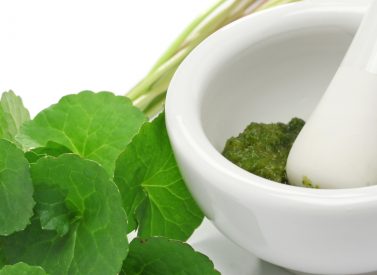Scientific Name: Centella asiatica
Constituents:
- Triterpenoid saponins (asiaticosides, madecassoside & brahmoside, brahminoside)
- Nutrients (Vitamins K & B, Na, Ca, Mg)
- Amino acids
- Flavonoids (quercitin & kaempferol)
- Volatile oils (Α-humulene, germacrene & β-caryphyllene)
- Phytosterols (phytosterols (campesterol, sitosterol & stigmasterol)
- Tannins
- Mucilage
- Resin
- Alkaloid (hydrochotine)
- Fatty acids (linoleic acids, linolnelic, oleic, palmitic and stearic acids).
Medicinal actions:
- Adaptogen
- Alterative
- Anti-inflammatory
- Bitter
- Connective tissue builder
- Diuretic
- Nervine Tonic & Neuroprotective
- Peripheral vasodilator
- Vulnerary
Mechanism of Action & Pharmacology:
- Triterpenoid saponins (asiaticoside) are vulnerary, anti-inflammatory, and considered to be responsible for anxiolytic effects. Will increase vascularization of connective tissue and the formation of structural glycosaminoglycans (chondroitin sulfate, hyaluronic acid).
- Brahmoside is a diuretic. Along with brahminoside may be responsible for CNS depressant and reduced motor activities (yet to be confirmed by clinical studies).
Pharmacy:
- Infusion
- Tincture
- Capsules
- Topical as poultice, oil, lotion or salve
Safety & Toxicity Concerns:
- Infusion: 1 tbsp/cup, infuse 10 min, TID.
- Tincture: (1:5, 45%), 1-2 ml TID. Max 40 ml/week.
- Capsules: 50-200 mg, TID, standardized to 40% asiaticosides.
- Topical as poultice, oil, lotion or salve.
- Pulse dose: 6 weeks on, 2 weeks off.
Interactions:
- May inhibit efficacy of anti-diabetic agents & anti-hyperlipidemics.
- May have additive effects with vasodilators, CNS depressants, and alter effects of GABAnergic medications.








